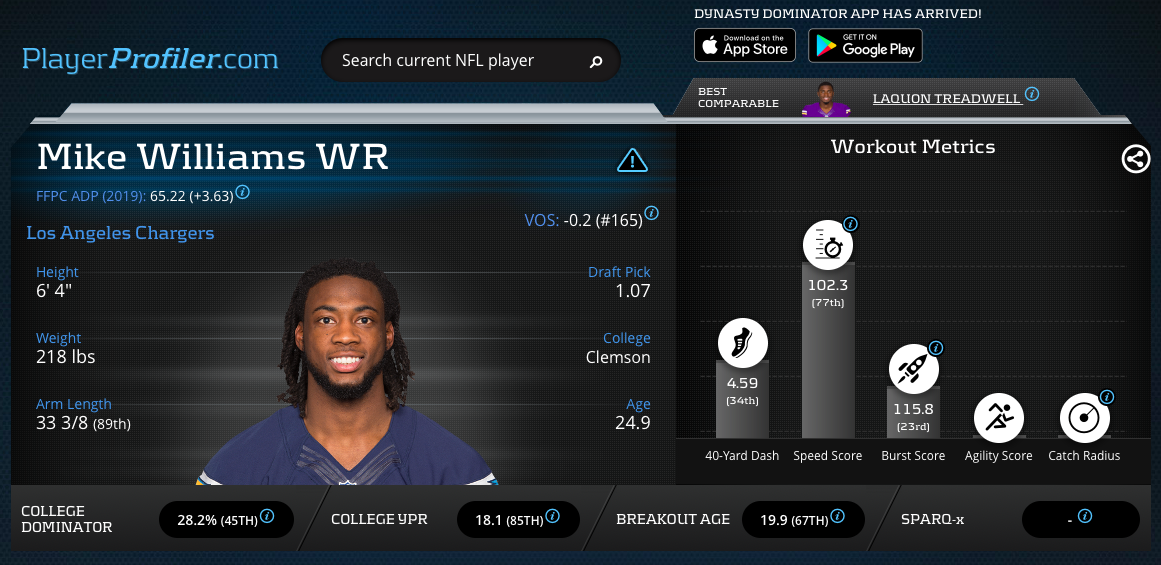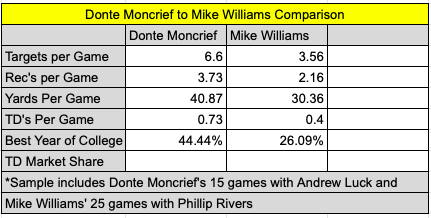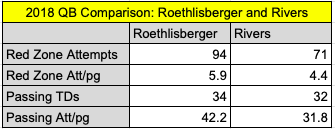Touchdowns are seductive. No doubt about it, they matter in fantasy football. Touchdowns make for big weeks and propelled Mike Williams to his top 24 finish in 2018. As seductive as touchdowns are in fantasy football, they are also unpredictable. Dez Bryant had a three touchdown season. Between seasons of double digit touchdown output, Eric Decker had a 5 touchdown season. If touchdowns are a part of what makes Williams attractive, they can be found elsewhere and at a more reasonable price. Based on his advanced stats, metrics, and analytics, Donte Moncrief is discount Williams.
College Production
It’s fair to ask if Mike Williams is the type of player fantasy gamers should expect to be a prolific touchdown scorer. Williams played his college football at Clemson, catching passes from Deshaun Watson. Taking a look at market share data, in Williams’ best year of college touchdown production he accounted for 26 percent of his team’s receiving TDs. Successful NFL receivers since 2003 have had an average of 40 percent of their team TD’s in their best year of production.
If we go a step further and compare Mike Williams to someone like Dez Bryant, who actually made a career of being a TD scorer, Williams falls further behind. Dez Bryant, in college, was an absolute red zone destroyer. He had a year wherein he scored 76 percent of his team’s receiving touchdowns. In fact, even Keenan Allen, who is not known as a TD scorer at all, had a larger share of his team’s receiving TD’s in each year of his college career than what Mike Williams did in his best year, with a peak of 46 percent of his team’s receiving TDs.
Touchdown Variance
The Chargers’ No. 7 overall draft pick in 2017, Mike Williams, had the touchdown variance season of a lifetime in 2018. On 66 targets (No. 65) and 43 receptions (No. 54) Williams scored 10 receiving touchdowns, which was the No. 5 highest number in the NFL. Based on his usage, Williams’ Expected Touchdown output was only 5.2 TDs. So he’s not actually being used in a way that would make this 11 touchdown outcome reasonable. His red zone snap share was only 60.1-percent, No. 51 overall. He received four targets inside the 5-yard line, No. 15 overall. He isn’t even making the most of those opportunities with a 57.1-percent end zone catch rate, which ranked No. 80 in the NFL. Again, these circumstances produced the wide receiver who was No. 5 in the league in touchdowns, because TD variance is real.
https://youtu.be/rVcIJ2OQVy4
Contested Catches
Looking away from metrics that are skewed by touchdown spikes, Williams does have at least one strength. Williams was 11th in contested catch rate with 50 percent, converting 9 of 18 contested targets. However, as much intuitive sense as it might make, there is no discernible connection between being good at Contested Catches, and scoring TDs. Alshon Jeffrey’s 57.7-percent Contested Catch Rate ranked No. 7 among qualified wide receivers and caught six touchdowns. D.J. Moore had a 53 percent Contested Catch Rate and had only 2 TDs. What touchdowns do follow, on a large scale, are Air Yards. Williams was not heavily utilized in any real sense. He received only 63.4 Air Yards Per Game, 58th overall.
Hunter Henry Looming
Hunter Henry makes his return to the team in 2019. Keenan Allen and Henry have shared a field before, and Allen held his volume. In Wiliams’ splits with Hunter Henry he drops nearly a full reception from 2.44 receptions per game to only 1.43. More alarmingly, in 7 games with Henry, Mike Williams has not caught a touchdown. The two players have seen very similar red zone usage. In 2017 Henry saw 9 targets inside the 10, which was 3rd among TE’s. Both players had exactly a 19.7 percent red zone target share in their last active year. It is only reasonable to expect Hunter Henry’s presence to take away some of Williams’ TD upside.
Donte Moncrief Comp
Available over 70 picks later than Mike Williams, at pick 141 in Fantasy Football Player’s Championship high stakes drafts, is Donte Moncrief. From the bottom up, Moncrief is a better bet than Williams. Moncrief actually has the college production profile of a red zone weapon. In not just one, but two years, Moncrief was responsible for scoring over 40 percent of his team’s receiving TD’s at Mississippi. That is legitimate red zone pedigree. That comes with an above average College Dominator Rating 32.1 57th percentile. More impressively he broke out just after his 18th birthday which puts him in the 100th percentile of college athletes.
Donte Moncrief is now playing in one of the NFL’s most prolific passing offenses. While a large part of that offense did walk out the door when Antonio Brown left, the Steelers are not going to reinvent everything they are. Ben Roethlisberger will continue to be the player he is, a player who took the fourth most red zone attempts last year with 94. Roethlisberger threw for over two thirds of the team’s 51 TD’s with 34 passing touchdowns.
Add to the mix Moncrief, standing in the back of the end zone with his 10.25 (89th percentile) Catch Radius and 133.2 (94th percentile) Burst Score. Rather than depending on mythical team red zone usage it’s a better idea to chase volume. Moncrief, when he played with Andrew Luck, saw over 6 targets a game. Last year, catching passes from a number of uninspiring quarterbacks in Jacksonville Moncrief attracted 1188 yds in Target Distance, which was just outside the top 24. Mike Williams, on the other hand was ranked 40th in Target Distance.
Conclusion
Mike Williams is not what he’s being sold to be. He’s not the next Dez Bryant. He had one season of incredible TD variance. Rounds and rounds later Donte Monciref is a bargain. He showed potential to be a red zone weapon on the college field. When he was paired with Andrew Luck, he earned more targets, yards, and even touchdowns per game than what Mike Williams has posted to the point in his career with Philip Rivers. Moncrief is again paired with quality quarterback play, on a team that throws the ball in the red zone. Don’t chase last year’s touchdowns. Find this year’s bargain.











